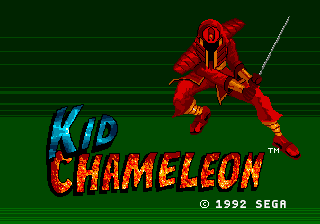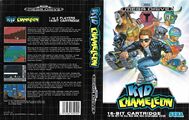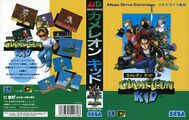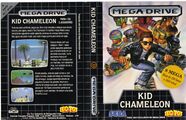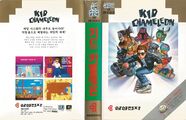Difference between revisions of "Kid Chameleon"
From Sega Retro
m (Text replacement - "==External Links==" to "==External links==") |
m (Text replacement - "==Production Credits==" to "==Production credits==") |
||
| Line 121: | Line 121: | ||
Level editing has been made possible with the release of [[K-E]]. K-E allows maps to be extracted from the ROM, modified, and imported back into the game for play. Up to 126 levels can be used in the game. | Level editing has been made possible with the release of [[K-E]]. K-E allows maps to be extracted from the ROM, modified, and imported back into the game for play. Up to 126 levels can be used in the game. | ||
| − | ==Production | + | ==Production credits== |
{{multicol| | {{multicol| | ||
'''Game Design''': Hoyt Ng, [[Broderick Macaraeg]], William G. Dunn, Graeme Bayless<br/> | '''Game Design''': Hoyt Ng, [[Broderick Macaraeg]], William G. Dunn, Graeme Bayless<br/> | ||
Revision as of 13:07, 24 March 2016
| Kid Chameleon | ||||||||||||||||||||
|---|---|---|---|---|---|---|---|---|---|---|---|---|---|---|---|---|---|---|---|---|
| System(s): Sega Mega Drive, Virtual Console, Steam | ||||||||||||||||||||
| Publisher: Sega | ||||||||||||||||||||
| Developer: Sega Technical Institute | ||||||||||||||||||||
| Sound driver: GEMS | ||||||||||||||||||||
| Genre: Action | ||||||||||||||||||||
| ||||||||||||||||||||
|
CERO
Missing Parameter! |
Kid Chameleon, called Chameleon Kid (カメレオンキッド) in Japan, is a platform game released for the Sega Mega Drive in 1992. The premise of the game is that the main character, "Kid Chameleon", can use masks to change into different characters to use different abilities.
The game is also a part of Sega Mega Drive Collection for the PlayStation 2 and PlayStation Portable. It was released for the Nintendo Wii's Virtual Console in Japan on 22 May 2007, North America on 28 May 2007 and Europe on 1 June 2007. It was also released in addition to a series of other Sega games, including Shining Force and Comix Zone, in Sega Smash Pack 2.
Contents
Story
A new virtual reality arcade game arrived in town and every kid played it. Nothing seemed out of the ordinary until kids began to disappear. The game's boss, Heady Metal, had freed himself from his scripted AI and was using his new freedom to kidnap every kid who could not beat the game, which was all of them—until now! Kid Chameleon enters the game and must defeat every level, every boss and Heady Metal himself if he wants to save the others.
Gameplay
The player, as Kid Chameleon, progresses through a series of levels. Most levels contain a flag, which is the primary goal of each level, from which the player progresses to the next level. However, a number of telepads throughout the game can warp the player not only to different places in the same level, but also to different levels, and sometimes to an entirely different path through the game. At the end of the game, Kid fights and defeats the final boss, Heady Metal. Kid Chameleon contains nearly a hundred levels, of which only about half are on the "main path" (traversing levels only by flags), and also counts the two-dozen smaller unnamed levels, simply called "Elsewhere". Despite the game's considerable length, there was no password system or other method of saving the game. However, both Sega Genesis Collection and the Virtual Console service allow players to save their progress mid-game.
As Kid Chameleon moves through the game's levels, he gains access to masks that transform him into different characters. Each character has different special abilities and varying amounts of hit points. The sheer amount of variety in gameplay due to the various characters is part of what gave Kid Chameleon such an addictive style; few levels repeated the same structure and they usually had specific strategies and characters to be beaten. In addition to the offensive abilities of each form, the Kid could also defeat enemies by jumping on them, although he may take damage from some enemies by doing so.
![]() jumps. Holding
jumps. Holding ![]() while moving runs.
while moving runs. ![]() uses a weapon provided by some transformations. Holding
uses a weapon provided by some transformations. Holding ![]() while moving crawls.
while moving crawls.
Characters
Diamond Powers
The collectable (a known platform game staple) in Kid Chameleon is the diamond. These differ in color depending on the stage in which they're found, but function the same as currency. Kid can use powers at a cost of 20 or 50 diamonds (with the exception of Juggernaut and Eyeclops, having attacks costing 5 and 2 diamonds respectively), and they are activated by holding the run button (by default A) and pressing Start.
Blocks
Kid Chameleon features 11 types of 'block' which adorn the levels. They are as follows:
- Prize Blocks offer rewards when hit, and leave Rock Blocks in their place.
- Rock Blocks are the most commonly-found block, and are destructible.
- Iron Blocks are indestructible, but Berzerker can push them.
- Rubber Blocks are indestructible and immovable. They function as 'bouncers' in this game, the height of the ascent depending on the height from which Kid landed on them. They also repel movement from other directions.
- Ice Blocks make maneuverability hard and when broken, shoot ice in the opposite direction from which they were broken (For example, Ice Blocks broken from beneath shoot icicles upward).
- Vanishing Blocks disappear the moment they were touched.
- Cannon Blocks are Vanishing Blocks which shoot one or more spikes in the directions marked on them. These spikes can destroy any destructible block, and are often used in conjunction with other Cannon Blocks to form a chain reaction, often clearing paths for the player.
- Shifting Blocks move upward when hit.
- Drill Blocks are Iron Blocks, with additional harmful drills which come out of one or more sides when Kid is in close proximity.
- Mushroom Blocks disappear when hit from beneath, and spawn as many as three additional mushroom blocks above them.
- Ghost Blocks phase in and out of existence.
All blocks, with the exception of the drills from the Drill Blocks, act as platforms, and can be stood upon.
Drill Wall
There are three levels throughout the game (starting with Hills of the Warrior 1) that feature a giant, metal wall covered in drills and augers that sweeps across the screen at a steady pace. These levels require the player to navigate and exit the map as quickly as possible, as coming in contact with the wall instantly kills Kid. These levels have a unique music theme, which becomes useful in identifying the danger early on.
It is possible to avoid two of these levels entirely, depending on the 'route' taken through the level progression; the first one being unavoidable.
Comic Adaptation
In August 1993, Kid Chameleon gained his own comic strip in the new Fleetway publication Sonic the Comic. The first strip ran from issues 7-12 and featured Casey entering the Wildside to rescue his friend Suzy, with a disembodied presence known as The Voice giving him advice and encouragement. Through each issue he changed into one of the different personas- Red Stealth, Eyeclops, Micromax, Berzerker and finally Iron Knight, before his Chameleon powers ran out and he had to take down a powerful enemy as his normal self. While he & Suzy escaped Wildside, the story ended with Casey discovering local school bully Brad was also trapped in Wildside. In issues 54-59 he returned again to rescue Brad, this time turning into Skycutter, Berzerker, Maniaxe and Cyclone. Here he discovered that The Voice had a more sinister agenda and was keeping children from all over the world prisoner in the Islecatraz gulag, using Brad as warden. Casey, as Cyclone, destroyed Islecatraz and freed everyone from Wildside, but when it became clear only one more person could escape, Brad sacrificed himself as penance for his sins so Casey could escape. The ending was ambiguous, with a showdown being threatened between Casey and The Voice, and fueled speculation that a third strip was imminent. Fleetway did not produce any more, however, and the story, like almost every non-Sonic strip, remains unresolved.
Level Editing
Level editing has been made possible with the release of K-E. K-E allows maps to be extracted from the ROM, modified, and imported back into the game for play. Up to 126 levels can be used in the game.
Production credits
Game Design: Hoyt Ng, Broderick Macaraeg, William G. Dunn, Graeme Bayless
Programming & Software: B. C. Tchiu Le, Bill Willis, Steve Woita, Mark Cerny
Art: Craig Stitt, Alan Ackerman, Judy Totoya, Brenda Ross, Paul Mica
Sound: Nu Romantic Production
Special Thanks: Scott Chandler, Hugh Bowen, Haven Dubrul, Test Group
Created By: Sega Technical Institute
Presented By: Sega & Sega of America
Promotional material
- KidChameleon MD US PrintAdvert.jpg
US print advert
- KidChameleon MD ES PrintAdvert.jpg
ES print advert
Physical scans
| 79 | |
|---|---|
| Based on 44 reviews | |
| Mega Drive, CA |
|---|
|
References
- ↑ 1.0 1.1 File:CVG UK 125.pdf, page 64 Cite error: Invalid
<ref>tag; name ":File:CVG UK 125.pdf_p64" defined multiple times with different content - ↑ 2.0 2.1 File:GamePro US 033.pdf, page 54 Cite error: Invalid
<ref>tag; name ":File:GamePro US 033.pdf_p54" defined multiple times with different content - ↑ 3.0 3.1 File:Joystick FR 027.pdf, page 140 Cite error: Invalid
<ref>tag; name ":File:Joystick FR 027.pdf_p140" defined multiple times with different content - ↑ 4.0 4.1 File:MDAG UK 02.pdf, page 79 Cite error: Invalid
<ref>tag; name ":File:MDAG UK 02.pdf_p79" defined multiple times with different content - ↑ 5.0 5.1 File:Mega UK 04.pdf, page 83 Cite error: Invalid
<ref>tag; name ":File:Mega UK 04.pdf_p83" defined multiple times with different content - ↑ File:MegaPlay US 11.pdf, page 62
- ↑ 7.0 7.1 File:MeanMachines UK 18.pdf, page 56 Cite error: Invalid
<ref>tag; name ":File:MeanMachines UK 18.pdf_p56" defined multiple times with different content - ↑ 8.0 8.1 File:PlayerOne FR 021.pdf, page 60 Cite error: Invalid
<ref>tag; name ":File:PlayerOne FR 021.pdf_p60" defined multiple times with different content - ↑ 9.0 9.1 File:SegaForce UK 04.pdf, page 12 Cite error: Invalid
<ref>tag; name ":File:SegaForce UK 04.pdf_p12" defined multiple times with different content - ↑ 10.0 10.1 File:SegaForce SE 1992 01.pdf, page 11 Cite error: Invalid
<ref>tag; name ":File:SegaForce SE 1992 01.pdf_p11" defined multiple times with different content - ↑ 11.0 11.1 File:SegaPro UK 06.pdf, page 68 Cite error: Invalid
<ref>tag; name ":File:SegaPro UK 06.pdf_p68" defined multiple times with different content - ↑ 12.0 12.1 File:VideoGames DE 1992-02.pdf, page 34 Cite error: Invalid
<ref>tag; name ":File:VideoGames DE 1992-02.pdf_p34" defined multiple times with different content - ↑ 1700 igr dlya Sega, "" (RU; 2001-xx-xx), page 110
- ↑ Beep! MegaDrive, "June 1992" (JP; 1992-05-08), page 30
- ↑ Consoles +, "Février 1992" (FR; 1992-0x-xx), page 48
- ↑ Console XS, "June/July 1992" (UK; 1992-04-23), page 131
- ↑ Electronic Gaming Monthly, "June 1992" (US; 1992-xx-xx), page 32
- ↑ Mean Machines: The Essential Sega Guide, "" (UK; 1993-11-18), page 64
- ↑ Famitsu, "1992-06-05" (JP; 1992-05-22), page 38
- ↑ Game Power, "Giugno 1992" (IT; 1992-0x-xx), page 46
- ↑ Games-X, "12th-18th March 1992" (UK; 1992-03-12), page 24
- ↑ Génération 4, "Juin 1992" (FR; 1992-xx-xx), page 151
- ↑ Game Informer, "Spring 1992" (US; 1992-0x-xx), page 7
- ↑ Hippon Super, "June 1992" (JP; 1992-05-02), page 95
- ↑ Hobby Consolas, "Abril 1992" (ES; 1992-0x-xx), page 22
- ↑ Joypad, "Mai 1992" (FR; 1992-04-1x), page 82
- ↑ Sega Mega Drive Advanced Gaming, "January 1993" (UK; 199x-xx-xx), page 93
- ↑ Mega Drive Fan, "August 1992" (JP; 1992-07-xx), page 99
- ↑ Mega Force, "Mai 1992" (FR; 1992-05-05), page 76
- ↑ Mega Fun, "06/92" (DE; 1992-0x-xx), page 28
- ↑ Mega Play, "August 1992" (US; 1992-0x-xx), page 62
- ↑ MegaTech, "April 1992" (UK; 1992-03-20), page 45
- ↑ Mean Machines Sega, "October 1992" (UK; 1992-09-xx), page 139
- ↑ Play Time, "6/92" (DE; 1992-05-06), page 92
- ↑ Power Up!, "Saturday, May 23, 1992" (UK; 1992-05-23), page 1
- ↑ Power Play, "5/92" (DE; 1992-04-15), page 145
- ↑ Sega Power, "May 1992" (UK; 1992-04-02), page 28
- ↑ Sega Pro, "April 1993" (UK; 1993-03-11), page 66
- ↑ Sega Mega Drive Review, "1" (RU; 1995-04-03), page 82
- ↑ Sega Saturn Magazine, "September 1995" (JP; 1995-08-08), page 87
- ↑ Supergame, "Junho 1992" (BR; 1992-06-xx), page 22
- ↑ Supersonic, "Septembre 1992" (FR; 1992-xx-xx), page 11
- ↑ Tricks 16 bit, "Tricks Sega Gold 800 igr" (RU; 1998-03-20), page 100
- ↑ User, "Dekémvrios 1992" (GR; 1992-1x-xx), page 50
- ↑ VideoGames & Computer Entertainment, "April 1992" (US; 1992-0x-xx), page 37
External links
- Pages with broken file links
- Pages with reference errors
- No players field
- JP Wii Virtual Console games
- All JP games
- US Wii Virtual Console games
- All US games
- EU Wii Virtual Console games
- All EU games
- Wii games
- All action games
- 2007 Wii games
- All 2007 games
- Wii Virtual Console games
- Old content rating field
- Use romtable template
- All games
- Old-style rating (consolesplus)
- Rating without PDF source
- Old-style rating (cvg)
- Use magref
- Old-style rating (gamepower)
- Rating without source
- Old-style rating (gamepro)
- Old-style rating (gamesx)
- Old-style rating (hobbyconsolas)
- Old-style rating (joypad)
- Old-style rating (joystick)
- Old-style rating (mdag)
- Old-style rating (mega)
- Old-style rating (megatech)
- Old-style rating (megaplay)
- Old-style rating (mm)
- Old-style rating (playerone)
- Old-style rating (pp)
- Old-style rating (sfuk)
- Old-style rating (sfsw)
- Old-style rating (segapower)
- Old-style rating (segapro)
- Old-style rating (videogames)
- Update ratings template
- 21 old ratings
- Sega Channel games
- Mega-Tech games
